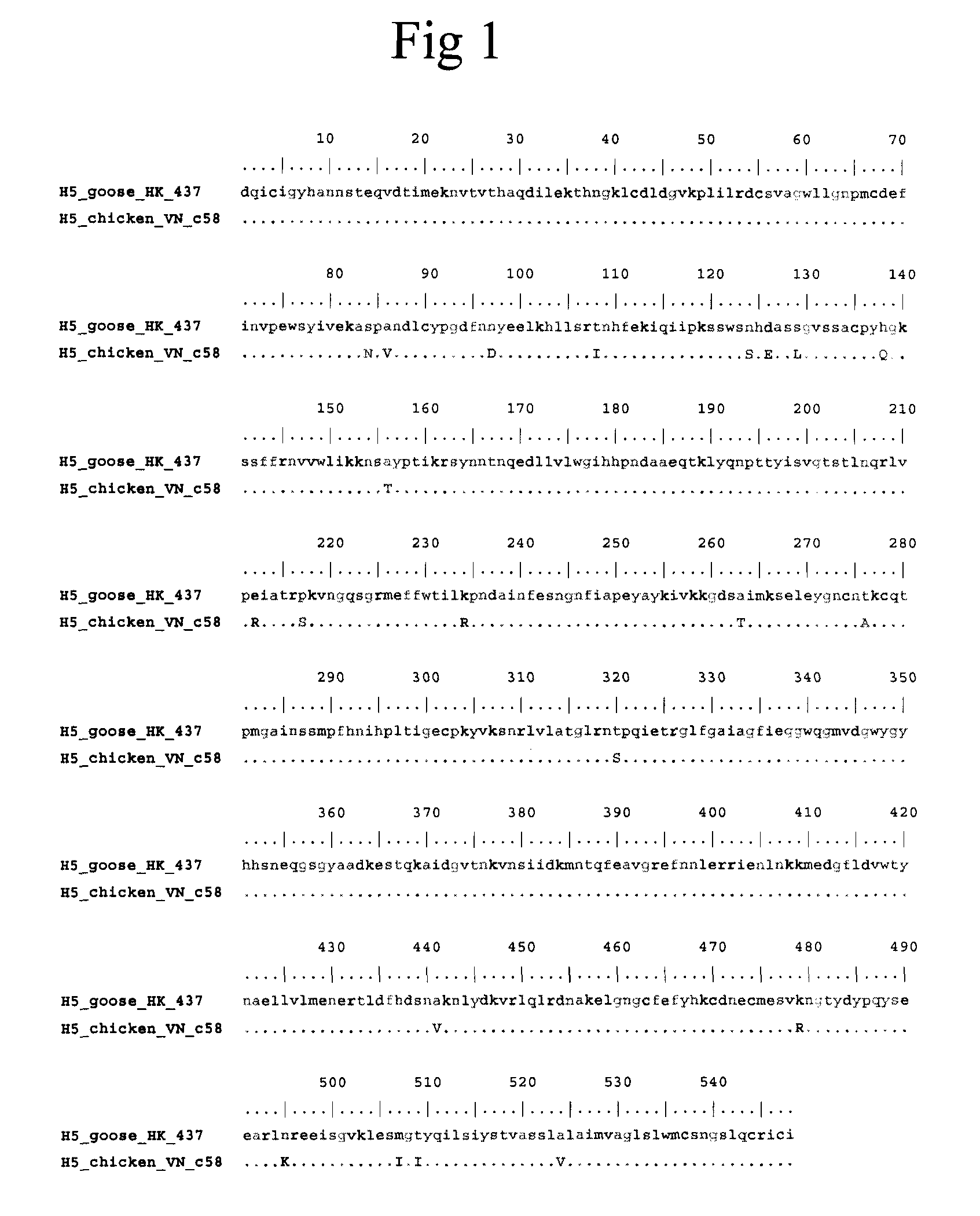Avian influenza viruses, vaccines, compositions, formulations, and methods
a technology for avian influenza and vaccines, applied in the field of avian influenza vaccines, can solve the problems of difficult vaccine preparation, high level of illness and death, and annual disease outbreaks, and achieve the effects of reducing or eliminating disease transmission, preventing growth, shedding, and transmission
- Summary
- Abstract
- Description
- Claims
- Application Information
AI Technical Summary
Benefits of technology
Problems solved by technology
Method used
Image
Examples
example 1
Construction of H5N3 Avian Influenza Vaccine
[0108]Viruses
[0109]Influenza viruses A / PR / 8 / 34 (H1N1), A / Chicken / Vietnam / C58 / 04 (H5N1), and A / DK / Germany / 1215 / 73 (H2N3) may be obtained from the repository of St. Jude Children's Research Hospital. A / Muscovy Duck / Vietnam / 453 / 2004H5N1 may be obtained from the Regional Animal Health Centre, Ho Chi Minh City, Vietnam.
[0110]RT-PCR and Construction of Plasmids
[0111]RNA is isolated from the A / Chicken / Vietnam / c58 / 04 (H5N1), A / PR / 8 / 34 (H1N1), and A / DK, Germany / 1215 / 73 (H2N3) influenza viruses using the RNeasy kit (Qiagen). RNA is reverse-transcribed to cDNA by using the Uni 12-primer (AGC AAA AGC AGG; SEQ ID NO: 3).
[0112]The resulting cDNA is then amplified using segment-specific primers described in Hoffmann et al. (2001) Arch. Virol. 146: 2275-2289, which is herein incorporated by reference. In particular, the segment-specific primers may be used as described in Table 1:
TABLE 1Primers that may be Used to Amplify Influenza ViralSegmentsGeneForwar...
example 2
Efficacy of Inactivated H5N3 Avian Influenza Vaccine in SPF Chickens
[0128]Composition of Vaccine
[0129]The efficacy of graded doses of an inactivated avian influenza H5N3 vaccine was tested. The avian influenza H5N3 vaccine was prepared essentially as described in Example 1. Four vaccines were prepared, one of which was a placebo vaccine containing virus-free allantoic fluid. The three remaining vaccines contained inactivated avian influenza viral stock to derive final formulations containing 1.2 ug HA protein (307 HAU) per 0.6 mL volume dose, 0.5 ug HA protein (128 HAU) per 0.5 mL volume dose or 0.25 ug HA protein (64 HAU) per 0.5 mL volume dose of antigen as measured by a radial immunodiffusion (or hemagglutination inhibition) assay of the virus stock formulated. The associated dose levels of the vaccines in terms of hemagglutinating units (HAU) were 64, 128 and 307 HAU / dose respectively. Inactivated antigen stock was prepared by one passage in Vero cells during construction of the...
example 3
Inactivated H5N3 Avian Influenze Vaccines in SPF Chickens
[0159]Five vaccines were prepared essentially as described in Example 1. The vaccines were formulated to contain the virus content per dose as listed in Table 7 (Table of Treatments). Virus concentrations in terms of HAU and EID50 measurements were based on pre-inactivation titration of the virus stock. Antigen concentrations as listed for ug H5 protein were based on post-inactivation measurement of the antigen stock using standardized single radial immunodiffusion (SRID). Based on these measurements of the stock antigen, and the percent antigen fluids formulated, the listed antigen quantities per dose were calculated.
[0160]Vaccines were formulated as water-in-oil emulsions (60:40 oil:aqueous ratio) with mineral oil as the carrier and Tween 80 and Arlacel 83 as emulsifiers. The Tween and antigen components were mixed separately from the Drakeol and Arlacel 83, and the aqueous phase was added slowly to the oil phase while stirr...
PUM
| Property | Measurement | Unit |
|---|---|---|
| size | aaaaa | aaaaa |
| volume | aaaaa | aaaaa |
| volume | aaaaa | aaaaa |
Abstract
Description
Claims
Application Information
 Login to View More
Login to View More - R&D
- Intellectual Property
- Life Sciences
- Materials
- Tech Scout
- Unparalleled Data Quality
- Higher Quality Content
- 60% Fewer Hallucinations
Browse by: Latest US Patents, China's latest patents, Technical Efficacy Thesaurus, Application Domain, Technology Topic, Popular Technical Reports.
© 2025 PatSnap. All rights reserved.Legal|Privacy policy|Modern Slavery Act Transparency Statement|Sitemap|About US| Contact US: help@patsnap.com

